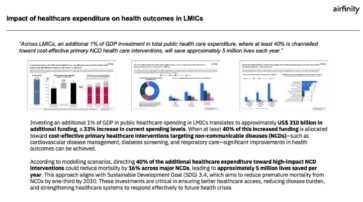Value of investment on NCDs: Impact on health outcomes in low- and middle-income countries

In new research commissioned by IFPMA, Airfinity has determined that an additional investment of 1% of GDP toward domestic general government health expenditure in low- and middle-income countries (LMICs) would amount to a US$ 310 billion additional investment, representing a 33% increase in current spending.
This research is a response to the UHC 2030 action agenda and policy asks inspired by the work of the Chatham House Commission on Universal Health and WHO for an increase of public health financing by around 1% of GDP.
According to the main findings of the research, in LMICs, an additional 1% of GDP investment in total public health care expenditure, where at least 40% is channeled toward cost-effective primary NCD health care interventions will save close to 5 million lives each year.
For this research, we focused on the WHO NCDs Best Buys. These interventions include cardiovascular disease management, diabetes screening, and respiratory care.
This analysis can inform health investment decisions, based on local priorities, country epidemiology, and disease management patterns in the context of geopolitical volatility and financing constraints. Further country analyses are required for the development of concrete and actionable national plans aiming to tackle the growing burden of NCDs in LMICs.


